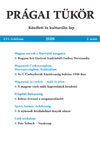
 |
| 2008/2 | resumé | ||
 tartalom e számunk szerzői bemutatkozik támogatóink
|
Summary
How Gyetvai András became Ondrej Detviansky is the title of a comprehensive interview in this second issue of Prágai Tükör. Gyetvai András was born in Hungary, later moved to Slovakia and finally settled down in the Czech Republic. He then became Ondrej Detviansky. The interview unravels his interesting fate. The second part of the series about the fateful number eight in Czechoslovak history is concerned with the breakdown of the First Czechoslovak Republic. A special attention is given to the fate of a Hungarian minority living in the south of Slovakia. A very interesting material by a historian Attila Simon is published in the section Hungarians in Bohemia, Moravia and Silesia. Iván Bottlik addresses the beginnings of Czech-Hungarian relations in chess, whereas G. Kovács László analyzes Hungarian motives in the works of Jaroslav Hašek. The articles are in the section Hungarians and Czechs - the past and the present. Political journalist József Szilvássy addresses the difficult situation of the Hungarian minority press in Slovakia in the section From Prague to Bucharest. The same section also contains an article about the foundation of the Central European Forum in Olomouc by the countries of the Visegrad Group. The section Library contains a review of the book Chapters from the Central European History written by a Czech historian Rudolf Kučera. The book has just been published in Hungary in Hungarian translation. The sports section brings a comprehensive article about a remarkable achievement in the 1980s by a female handball team from a small village Topolníky in southern Slovakia. The author of the article is Vince Tomi. The extract from a Czech literature - this time from the works of Petr Šabach - was translated by Margit Zádor. A regular appendix of the magazine Tükörkép informs that a new prime organization of the Federation of Hungarians living in the Czech Lands was founded in Olomouc. It also publishes a declaration that was released by the Coexistentia movement with regards to the day of Hungarian national solidarity. A regular part of the appendix is the children's section.
|
||